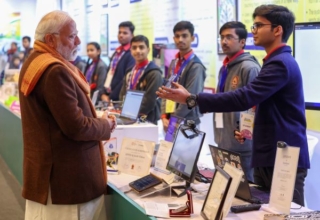
Last year, the Institute of Applied Manpower Research (IAMR) of the erstwhile Planning Commission published a research paper, ‘China’s skill development & training; Lessons for India.” We are reproducing its abridged summary while wondering why Govt didn’t take any lessons till date from this evidence
For the past two decades, the Chinese economy has been growing by over 10 per cent per annum. Keeping in mind the needs of a growing economy, Chinese planners gave much importance to educational reforms, especially vocational educational reforms. Vocational education in the Chinese school system is introduced at the junior secondary level (or junior middle school) for students in the age group of 12-14 year olds. Junior level secondary schooling is the last 3-year stage of the 9 years of compulsory schooling mandated by the NineYear Compulsory Education Law of 1986. The element of vocational education is however fading away at the junior secondary level over the years. Unlike India, after the junior secondary level, each student is required to undertake the Senior High School Entrance Examination called the ‘Zhongkao’, the score in which determines the entry into general academic and vocational education schools. Typically, middle school graduates with lower marks end up in the senior secondary vocational stream. After completing 9 years of compulsory schooling, only about 11.6 per cent junior secondary graduates enter(ed) the workforce (2012) in contrast to India, where the share is much higher. Out of the 88.4 per cent continuing senior secondary education, the proportion of those entering the vocational stream, is about 47 per cent. That is almost half of the junior secondary graduates who enter the vocational secondary schools again in total contrast to the situation in India. In 2011, there were about 13,093 schools under vocational secondary education (China Statistical Yearbook, 2012). These schools are classified into four categories, depending upon iii their sponsoring organization and trades/subjects taught regular specialized schools (3,753), adult specialized schools (1,614), vocational senior secondary schools (4,802) (all under the Ministry of Education), and technical schools, also known as skilled workers schools (2,924) (under the Ministry of Human Resources and Social Security). Vocational education at the senior secondary level is for three-four years duration (depending upon the trade), of which the last year entails field training at the enterprises in the related subjects/trades. Public-private partnership takes a concrete form in China. All enterprises as a policy are required to utilize 1.5 per cent of their payroll towards in-service training, which if they fail to do, should contribute to the government to be used towards adult training. (No such requirement exists on Indian firms.) However, without the legal backing of the law, not all enterprises are contributing to such training fund. Given that, township and country governments (and their mayors) have since the economic reforms began in 1979, had much more autonomy and power than local government in India, the support to enterprises by the local government is a crucial aspect of industry participation in TVET. Incentives such as allotment of land at subsidized prices, and preferential treatment in case of award of government projects, do prove to be influential in encouraging industry to actively participate in vocational education and training. To increase participation in the vocational education stream and support students from poorer economic backgrounds, the government initiated various measures. Since 2006 over 40 billion Yuan (OECD, 2010; Wang, 2010) has been spent on vocational education, with more than half financed by the local levels of government. To overcome the financial burden and to ensure that the poor students continue in VET schools, a national scheme was introduced to offer a subsidy of 1500 Yuan per year per student, for their first two years at secondary vocational schools to cover their fees. Since 2009, an initiative has been taken to make tuition fees for senior secondary vocational schools free of cost for all students. This policy recognises the fact that vocational education in China is not an aspirational (as in India); it also recognises the fact that poor students face a financial cost if they undertake vocational education and also an opportunity cost as they are not earning a wage by joining the labour market.
The curriculum of a senior secondary vocational school is designed such that, one- third includes general academic skills defined nationally by the Ministry of Education, another one- third is again nationally defined content associated with the particular occupation, and the remaining one- third defined again with respect to the occupational field is determined locally at the school level with the help of local enterprises. Another important aspect of TVET is training of teachers and instructors at vocational schools to be at par with new technologies and needs of modern industry. There are strict requirements of teachers being hired at vocational schools and colleges. Teachers hired to teach at the senior secondary level must possess undergraduate degrees (there is no such requirement in India) and those who are to teach in vocational undergraduate colleges must themselves be postgraduate degree holders in that particular field along with the occupational certificate in that respective trade. In addition, teachers in vocational schools are required to undergo one month in industry each year, or two months every two years for their career progression and promotion. There is no such requirement either for vocational education teachers in senior secondary schools in India or for ITI teachers in ITIs (public or private). According to the 1996 Vocational Education Law, China’s vocational training includes pre-job training, job transfer training, apprentice training and on-the-job training and entrepreneurship training.











